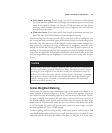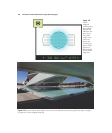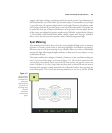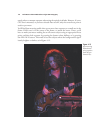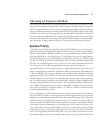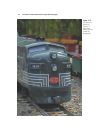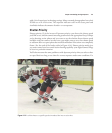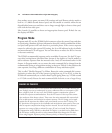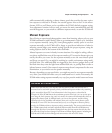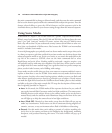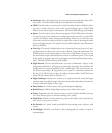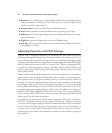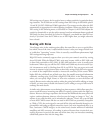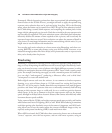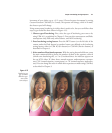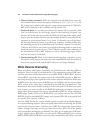
while automatically producing a shorter shutter speed that provides the same equiva-
lent exposure as metered in P mode. An asterisk appears next to the P in the mono-
chrome LCD so you’ll know you’ve overridden the D7000’s default program setting.
Your adjustment remains in force until you rotate the main command dial until the
asterisk disappears, or you switch to a different exposure mode, or turn the D7000 off.
Manual Exposure
Part of being an experienced photographer comes from knowing when to rely on your
D7000’s automation (with P mode), when to go semiautomatic (with S or A), and when
to set exposure manually (using M). Some photographers actually prefer to set their
exposure manually, as the D7000 will be happy to provide an indication of when its
metering system judges your manual settings provide the proper exposure, using the
analog exposure scale at the bottom of the viewfinder.
Manual exposure can come in handy in some situations. You might be taking a silhou-
ette photo and find that none of the exposure modes or EV correction features give you
exactly the effect you want. Set the exposure manually to use the exact shutter speed
and f/stop you need. Or, you might be working in a studio environment using multi-
ple flash units. The additional flash are triggered by slave devices (gadgets that set off
the flash when they sense the light from another flash unit, or, perhaps from a radio or
infrared remote control). Your camera’s exposure meter doesn’t compensate for the extra
illumination, so you need to set the aperture manually.
Because, depending on your proclivities, you might not need to set exposure manually
very often, you should still make sure you understand how it works. Fortunately, the
D7000 makes setting exposure manually very easy. Just press the mode button and rotate
Chapter 4 ■ Getting the Right Exposure 115
METERING WITH OLDER LENSES
Older lenses that lack the CPU chip that tells the Nikon D7000 what kind of lens is
mounted can be used with Aperture-priority and Manual exposure modes only, assuming
you’ve entered the Non-CPU Lens information in the Setup menu, as described in
Chapter 10. If the D7000 knows the maximum aperture of the lens, you can set the aper-
ture using the lens’s aperture ring, and, in A mode, the camera will automatically select an
appropriate shutter speed. In Manual mode, you can set the aperture, and the analog
exposure scale in the viewfinder will indicate when you’ve set the correct shutter speed
manually. If a non-CPU lens is mounted and you try to set Program or Shutter-priority
modes, the D7000 switches to Aperture-priority automatically. The process works because
the D7000 camera body and other advanced Nikon models (from the old D200 on up
through the D3x) have a mechanical linkage built into the lens mount that tells the cam-
era when the f/stop has been changed. Less advanced Nikon digital cameras, including the
D5100 and D3100, lack this linkage and cannot meter with non-CPU lenses.



